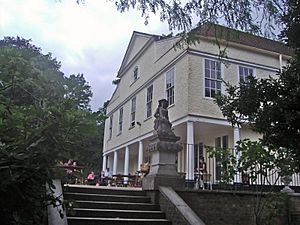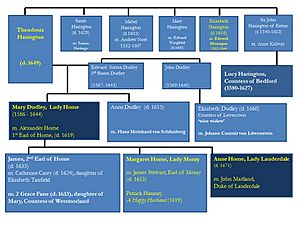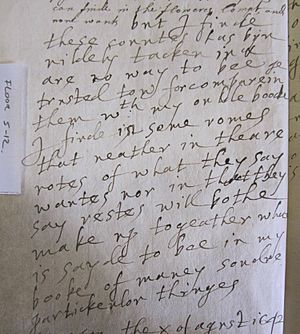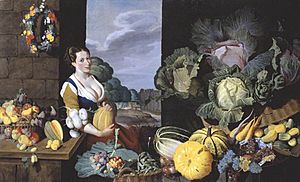Mary Sutton, Countess of Home facts for kids
Quick facts for kids Mary Sutton |
|
|---|---|
| Countess of Home | |
| Spouse(s) | Alexander Home, 1st Earl of Home |
| Issue | |
| James Home, 2nd Earl of Home Margaret Home, Countess of Moray Anne Home, Countess of Lauderdale |
|
| Father | Edward Sutton, 5th Baron Dudley |
| Mother | Theodosia Harington |
| Born | 2 October 1586 |
| Died | 1644 |
Mary (Dudley) Sutton, Countess of Home (1586–1644), was an important noblewoman who owned land in both England and Scotland. She lived during a time when England and Scotland were becoming closer under one king. Mary was known for managing her large estates and for her connections to the royal court.
Contents
Mary's Early Life and Marriage
Mary (Dudley) Sutton was born on October 2, 1586. She was the oldest daughter of Edward Sutton, 5th Baron Dudley and Theodosia Harington. Her family used both "Dudley" and "Sutton" as their last name.
Mary's childhood was a bit difficult because her father left her mother. When she was young, her younger brother and sister were looked after by their aunt and uncle. Mary was friends with Lady Anne Clifford when they were children. Lady Anne called Mary her "old companion."
After King James VI of Scotland also became King James I of England in 1603 (this was called the Union of the Crowns), Mary's mother, Theodosia Harington, became an important person in Princess Elizabeth's household. Princess Elizabeth later married Frederick V.
Mary's sister, Anne Dudley, was a lady-in-waiting to Princess Elizabeth. Anne gave Lady Home a special ring shaped like a heart. Another cousin, Elizabeth Dudley, also worked for Princess Elizabeth. Because of these family connections, the Countess of Home likely supported Princess Elizabeth, who became the Queen of Bohemia.
Mary's youngest sister, Margaret Dudley, married Miles Hobart in 1627. Later, their mother, Theodosia Dudley, moved to Norfolk to be closer to Margaret.
On July 11, 1605, Mary married Alexander Home, 1st Earl of Home. He was a wealthy Scottish nobleman who had been married before. King James I likely arranged this marriage to help bring the English and Scottish noble families closer. The king even gave Mary an annual payment of £300. Mary often traveled to London. In 1616, she met her cousin, Lucy Russell, Countess of Bedford, at her house in London.
Celebrating a Special Marriage
Mary and Alexander's families had a surprising historical link. Mary's grandfather had once captured Hume Castle from Alexander Home's grandmother in Scotland. This connection was celebrated when King James visited Dunglass Castle in 1617.
A poet named David Hume of Godscroft wrote a Latin poem for the occasion. The poem praised Mary for rebuilding the Earl's homes. It said that her "better English hand" was now building up what an English hand had once destroyed during a past war. The poem suggested that if everyone followed Mary's example, the union between England and Scotland would be very successful.
Life as a Widow
Alexander, Earl of Home, passed away on April 5, 1619, in London. Lady Home became very wealthy after his death. She had to protect her young son's rights to his large estates in Scotland. She did this with the help of family members and important people from the Home family.
Around 1630, Abraham Hume was her chaplain (a private priest). He later traveled with her son-in-law, John Maitland, 1st Duke of Lauderdale, on a grand tour of Europe.
Working with a Lawyer
The Countess of Home hired a lawyer named Sir Thomas Hope of Craighall. He wrote about some of her business dealings in his diary. In 1634, she visited him in Edinburgh with her family, including her son-in-law and her daughter Margaret. They offered him money for his help with a legal case.
Land Disputes
Mary had disagreements over who owned certain lands, especially around Coldingham Priory. She argued with Francis and John Stewart, sons of Francis Stewart, 5th Earl of Bothwell, about these lands for many years. Even King James I and King Charles I got involved.
She also dealt with land around the Hirsel estate, which was part of Coldstream Priory. She worked to benefit her son's ownership of these lands.
Cockburnspath
In 1634, Mary made an agreement with John Arnot, the postmaster of Cockburnspath. He agreed to repair a barn and barnyard for her and keep it in good condition. In return, he could use it for a yearly payment. Lady Home also paid the minister's salary in Cockburnspath.
Many Special Things
Mary had homes in London and Edinburgh. She hired famous builders and artists to work on her house in Aldersgate, London, which later became known as Lauderdale House. She also built a summerhouse at Twickenham Park and decorated it with fancy blue leather. At Highgate, she made an existing building larger, which is now called Lauderdale House.
In Edinburgh, she rebuilt a house in the Canongate, now called Moray House. She hired a master builder and a painter for the job. Her garden there had terraces, paths, and two summerhouses. She grew many kinds of fruit trees, like cherry, plum, apple, and fig. Lady Home even wrote a list of rules for her gardeners, telling them not to sell any of the garden's produce. She owned a book about plants by John Parkinson. She was also connected to artists like Nathaniel Bacon, who painted pictures of fruit and vegetables.

Mary kept detailed lists of everything in her houses. These lists show what she bought in London, including beds, tapestries, and books. She had equipment for making distilled liquids, magnets, telescopes, and weather glasses. She also had bronze statues. Her lists mention paintings she bought, many with religious scenes. She even got items with her family's special knot design from her cousin, the Countess of Bedford.
These lists also include notes she wrote to her housekeepers and their replies, like short conversations. Lady Home once wrote that a list was "wildely tacken in" and could not be trusted.
Her housekeeper at Floors, Jane Descheil, managed many tasks. She paid cleaners, fed the animals, brewed ale, made honey, and supervised repairs. At Twickenham Park, the housekeeper, Judith Plummer, embroidered a special bedsheet that Mary loved.
In the 1630s and 1640s, it became popular to have life-sized painted figures of servants or family members, called "dummy boards." Lady Home had some of these made in London. They included a shepherdess, a maid, and a man playing a musical instrument. In her Edinburgh house, she had three "standing pictures" of her two grandchildren and their attendant, a dwarf named Meg Candie.
Nicholas Stone
In 1638, Mary talked with the famous sculptor Nicholas Stone about designing a tomb for her family at Dunglass. She wanted it to have white and black marble, with statues of her, her husband, and her son from the waist up. However, this tomb was never built.
Dunglass Castle was destroyed by an explosion in 1640. Fifty-two people died, including an English plasterer who also worked for Mary. That same year, she sold her property at Twickenham Park.
Marriages of Her Son, James Home
In May 1622, Mary's son, James Home, 2nd Earl of Home, married Catherine Cary at Whitehall Palace. King James had arranged this marriage. Before the wedding, the king asked a lawyer to tell the Home family leaders about the marriage plans. They agreed to help the Earl but wanted Lady Home to ask for their advice.
After Catherine died in childbirth in 1625, James married Grace Fane. James still had legal guardians, including the Earl Marischal and the Earl of Morton. Mary wrote to the Earl of Morton for help with payments related to the marriage. She wanted cash sent to Scotland for her daughters' dowries (money or property a bride brings to a marriage).
Grace's mother, Mary Mildmay Fane, wrote letters to Grace in Scotland, asking about her health. She hoped Grace would visit London to see the court masques (special plays with music and dancing). James Home died in London in February 1633, and Grace died soon after. The two mothers continued a difficult legal fight over their children's properties.
The earldom (the title of Earl) then went to a distant cousin, James Home, 3rd Earl of Home. Mary wrote to Sir David Home about the future of the Home family after her son's death.
Lady Moray and Lady Lauderdale
A Scottish writer named Patrick Hannay dedicated a book called A happy husband to Mary's oldest daughter, Margaret Home. Margaret married James Stewart, 4th Earl of Moray in 1628.
In 1632, Mary's younger daughter, Lady Anne Home, married John Maitland, 1st Duke of Lauderdale. Anne later inherited her mother's properties and furniture in London.
Lady Home's Will
Mary made her will in 1638. She wanted her granddaughters to inherit her furniture and collections, dividing items between her London and Scottish homes. She knew this might be complicated because of the laws in England and Scotland.
She left gifts to her family and servants, including a purse of gold coins for her nephew, Frederick Schomberg, 1st Duke of Schomberg. Mary's granddaughter, Lady Mary Stewart, was named as the person to carry out the will, but she was too young when Mary died in London in March 1644. Mary's body was sent to Scotland and buried at Dunglass. Her daughters and their husbands carried out the will instead.
The Will and the Commonwealth
In 1648, some of Lauderdale's possessions and furniture in London were taken by the government because of his actions during the English Civil War. Even though it was argued that the items belonged to his daughter or had been sold, they were still taken.
It was also discovered that Mary had lent a lot of money to other nobles. This led to more legal battles. Because of all these legal issues and the need to divide her belongings, Mary's detailed lists of her household items survived. These lists give us a special look into the life of a wealthy Anglo-Scottish noblewoman in the 1630s.
Mary's Children
Lady Home had seven children, all born in Scotland with the help of an English midwife. Three of her children lived to be adults: James, Margaret, and Anne. One child was born in October 1612. Anne of Denmark, the Queen, sent gifts of money for the christening (naming ceremony). This child was probably Anne, named after the Queen.
- James Home, 2nd Earl of Home (died 1633) first married Catherine Cary. After Catherine died, James married Grace Fane.
- Margaret Home, Countess of Moray, who married James Stuart, 4th Earl of Moray.
- Anne Home, Countess of Lauderdale (died 1671), who married John Maitland, 1st Duke of Lauderdale. Their daughter, Mary Maitland, married John Hay, 2nd Marquess of Tweeddale.






